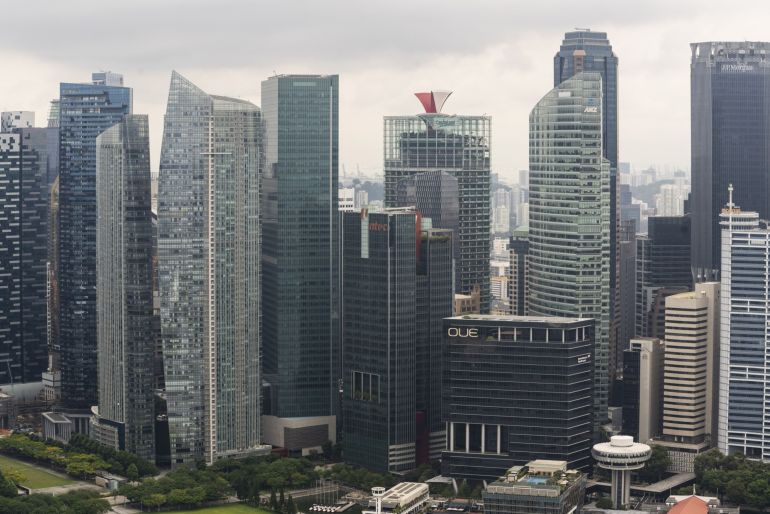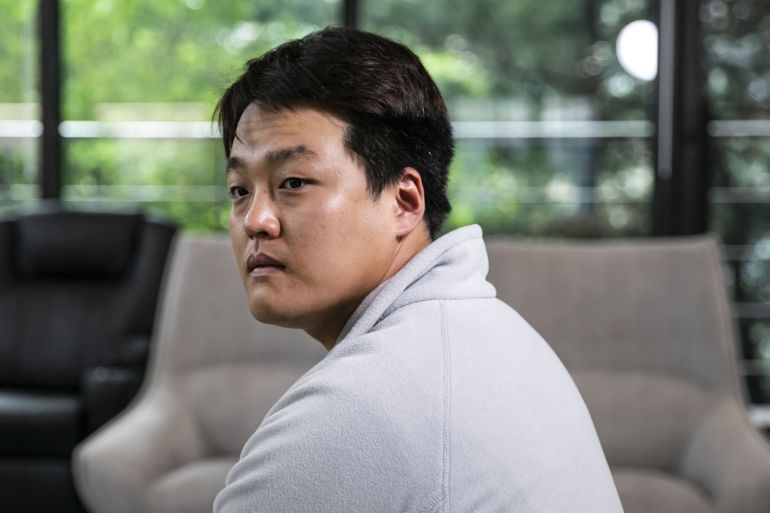After Terra, Luna crashes, regulators count cost of crypto
Spectacular collapse of stablecoin puts focus on regulatory frameworks in South Korea and Singapore.

Taipei, Taiwan – As the crypto winter deepened this month, one wealth-destroying event – the collapse of the TerraUSD (UST) and Luna coins – has brought the human cost of unstable cryptocurrency projects to the surface.
UST, a so-called “algorithmic stablecoin,” plummeted over the last week as it lost its peg against the US dollar and sent its sistercoin Luna crashing to zero, erasing about $45bn. The crash wiped out the savings of untold numbers of investors overnight.
Keep reading
list of 4 itemsSri Lanka bank says fuel shortage set to ease as students protest
‘Difficult to believe’: Biden’s economy plan a tough sell in Asia
Russia has turned Donbas into ‘hell’, Zelenskyy says
“I felt my heart sink watching Luna go into that downward spiral,” Hank Kennedy, a factory worker in Chicago, told Al Jazeera. “It (the crash) has had a huge impact on my life.
“Now I’m behind on all my bills, and I’ve lost $40,000, which was everything I had in my savings,” Kennedy added. “I was actually thinking that I would be able to make enough money to pay my home off, but instead, I’ve lost everything.”
The incident epitomises regulators’ nightmare scenario of crypto projects going wrong and prompted US Treasury Secretary Janet Yellen to call for regulation of stablecoins – whose selling point is their supposed stability due to being pegged to another currency or commodity – by year’s end. Former lawyers at the Securities and Exchange Commission (SEC) say the agency is probably already investigating the case.
In Asia, regulators may also have impetus to act.
Do Kwon, the creator of the cryptos, is a South Korean national, while Terraform Labs and the Luna Foundation Guard, the organisations that support the digital coins, are both registered in Singapore.
South Korean authorities launched an “emergency investigation” into the case this week. Investors in Singapore have filed police reports, although authorities have yet to make any move.
Kwon wrote on Twitter last week that he was “heartbroken” about the pain his invention had brought investors and that neither he nor the companies associated with the project had sold UST or Luna to profit from the crash. The statements came after the founder earlier that day proposed a “revival plan” to restart the network and distribute ownership of the project via one billion new tokens issued to holders of the collapsed currency. Kwon and the Luna Foundation Guard did not respond to requests for comment before publication.
The crash comes amid a rethink of the city state’s regulatory approach to digital assets as it tries to position itself as a responsible crypto hub. Singapore’s response could set a precedent as the social and economic costs of poorly managed projects come into sharper focus.

“The government of Singapore is not going to be impressed that a firm registered in its country, with no real material ties to the city-state, has caused such damage to investors around the world,” Sam Reynolds, a Taipei-based crypto analyst at CoinDesk, told Al Jazeera.
“This is likely to lead to a further tightening of rules surrounding crypto firms registered in Singapore for jurisdictional preference yet conducting business primarily abroad,” he added.
Singapore’s parliament had already passed a law last month to increase oversight of firms like Luna that are domestically registered crypto companies but mainly operate abroad.
Under its Payments Services Act 2019, entities that offer payment instruments, such as algorithmic stablecoins, require a Digital Payment Token Services (DPTS) licence. Though Singapore has only issued a DPTS licence to a handful of firms, it has granted many more companies temporary exemptions from the law.
Yet when billions went up in smoke up this month, Kwon’s organizations had neither a DPTS licence nor an official exemption, according to Singapore’s Financial Institutions Directory.
Its failure to register is the first of three interrelated factors that lay compelling grounds for legal intervention by the city-state, according to Anndy Lian, a Singaporean crypto thought leader and author of Blockchain Revolution 2030.
“The second (factor) is this was a stablecoin,” Lian said, noting that since it was advertised as having parity with the US dollar and boasted 20 percent yields, it appealed to investors looking to stake their savings over time. This differentiates it from other cryptocurrencies whose price floats freely and are conducive to speculative trading.
“That means many retail investors got hurt on the pretext they had bought into the project because it is a stablecoin,” said Lian.
“From a Singaporean perspective, if you are a retail investor and you feel that you have been a victim of fraud, and have lost a certain amount of dollars on paper even though you held your investment and did not sell … that is a possible lawsuit Singaporeans can pursue or the government can pursue,” he said.
Cooperation with foreign regulators
The third reason is Kwon’s planned “fork” – the closing of the original network and launching a substitute – which has been put forth to revive the currency. Lian said such a move would “dilute all the shareholders” and redistribute the tokens in a way that is likely to be highly inequitable.
“I think the Singaporean government will surely take some action after the fork is attempted,” he said.
South Korea’s Financial Supervisory Service (FSS) said this week that increased cooperation with foreign authorities is needed to regulate crypto after the Luna crash.
Lian believes Singapore may coordinate with foreign regulators on the case, too.
“Because this is a global event, there might be a common interest for the US and Singapore to work together on this case,” he said.
Lian said any action should not set the wrong precedent by insulating crypto investors from all losses.
“It would be misleading if investors believed they can claim losses from all altcoins. This was different since this was a stablecoin. We need to make that demarcation very clear,” he said.
“I think more regulatory clarity would need to be established before crypto-specific cooperation with countries could happen,” Reynolds said, referring to the continuing lawsuit between Terraform Labs and the SEC that seeks to establish if the financial watchdog has jurisdiction over the project.
Even if the company were found liable, it is unclear whether it has the assets to repay investors.
“The question would be, what assets would Terraform Labs and the Luna Foundation Guard have to repay investors?” Reynolds said.
“The Luna Foundation Guard, with its current balance sheet, could only pay out pennies on the dollar. And aside from those balances, it is unlikely that Terraform Labs has material assets sufficient to pay out any claims against it in a meaningful way,” he added.
“Before this happens, we would also need a determination if the collapse happened because of fraud, negligence, a coordinated attack, or market rejection of the platform. Right now, that’s not clear.”

Lian said regulators will look for a strong expression of shared grievances to justify moving forward with a case in Singapore.
In recent days, an online community in South Korea named “Victims of Terra-Luna coin” has been formed for this purpose.
Kennedy, the US worker who lost his funds, said he would readily join a class action lawsuit against Kwon.
“(This is) the reason why people like me try to talk with him on Twitter every day … to get some type of answers,” he said.
As regulators mull over their next move, the saga has offered industry players a moment of pause to reflect on what constitutes good governance and sound investing.
“It will take time to get the trust back,” Lian said, adding the case has spooked institutional investors in Singapore.
“I think we need to rethink what decentralisation means. What will happen next with Luna will not be based on any consensus formed among its community.”
Reynolds said investors should do their research and ensure they have diversified their assets.
“On paper, algorithmic stablecoins were a good idea but the industry is coming dangerously close to a ‘2008 moment’ as a result of one project’s outsized ambition,” he said. “The VCs that backed Terra need to have a serious think about how we got to this moment.”